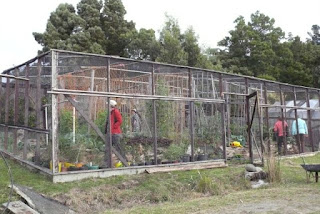On Sunday 18 May we visited Gordon's garden at Simpson Bay, Bruny Island
Gordon and Annie bought their large block of land at Simpson Bay around a decade ago. At that stage it was covered with Macrocarpa and Radiata pine trees. They removed most of them and then designed and with the help of a son built a very special house out of the timber. These days their North-facing block of land is mostly open, but surrounded by bush, except on the North-side where there is wonderful view over the water and The Neck.
They built three wildlife-proof food-growing areas. The first one is a large two-storey-high hothouse that forms the front of their house:
 |
| I took this photo from a balcony that you enter from the kitchen. I am looking at the top part of the hothouse. |

A White Genoa fig tree is obviously very happy in these warm conditions
Here is another shot in the hothouse:
Here is their second wildlife-proof food-growing area that is used for vegetables and fruit:
And here is the entrance of the third one which is many times bigger and mostly devoted to growing of fruit and berries. It is completely surrounded by netting.
 |
Espaliered fruit trees
|
Golden Delicious ready for picking:
Water is collected from a number of large roof surfaces in tanks that have a total capacity of 60,000 litres. Gordon has an auto-timer system with dripper tubes. Each area is watered 8 minutes each day. They have never had to buy water, but have come close to it a few times.
Drip irrigation pipes laid in circles to facilitate even water distribution
Max K, our fruit tree expert, was full of praise, but also had some advice.
Below is a photo of an Italian zucchini called Rampicante. It is firmer and nuttier than a Lebanese zucchini.
 |
| This
is an Italian zucchini called Rampicante |
Gordon demonstrated building the top third of a compost heap. In the bath tub is clay that he thoroughly mixed with water.
Gordon believes that adding clay to his compost makes the end result a lot better (see a recent post on this blog). All compost heap ingredients are submerged in the clay mix, then put on the metal sieve on the left to get rid of some of the moisture, and then they are added to the heap. Gordon feels that mixing all compost heap ingredients is much better than creating layers of the various ingredients.
The end result of his composting is a dark brown crumbly chocolate soil that he simply puts in a thin layer on top of his soil or mixes with water in a watering can and then pours over plants.
Many thanks, Gordon, for providing us with such an informative and inspirational Sunday afternoon. We were all impressed with your methods and results.
Many thanks too to Annie for providing a great afternoon tea and thank you everyone who arrived with a contribution, in spite of having to travel to Kettering and taking things on the ferry and the bus.
The weather was fine. It was interesting to see Bruny Island again on the ferry and the bus and I was happy with the fact that I broke even with the bus fares. All was good. Everyone had a wonderful time.
This text was previously published on the Food Garden Group blog. It was written
by Max Bee. |











No comments:
Post a Comment
Note: Only a member of this blog may post a comment.